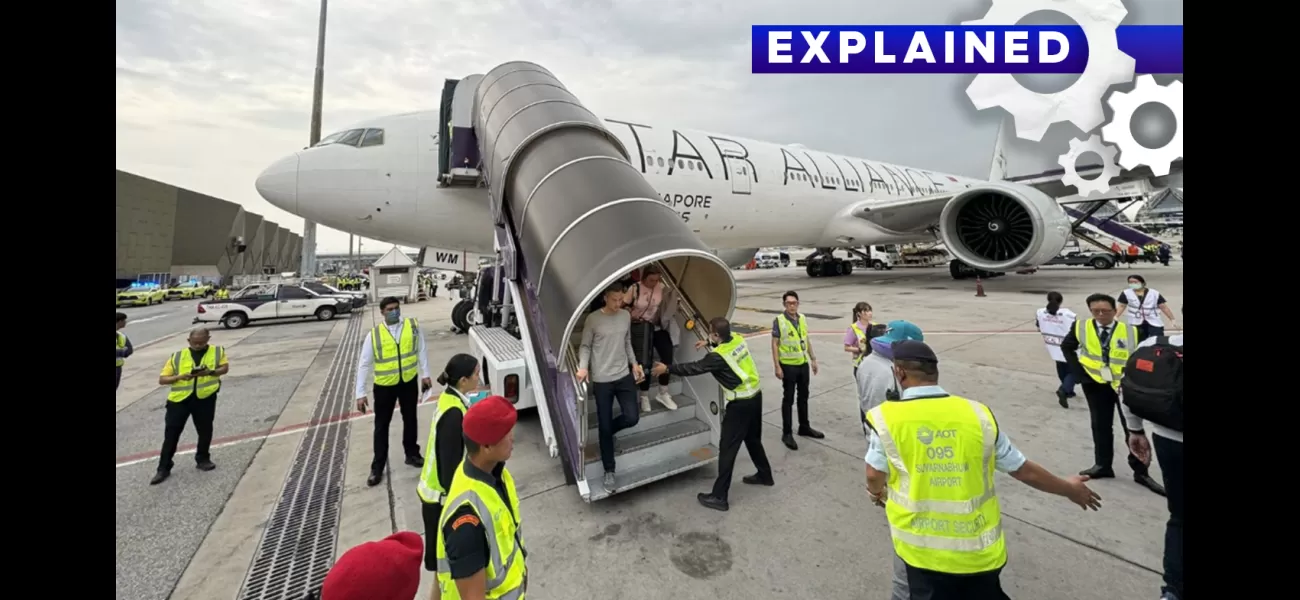Airline turbulence is an unpredictable factor that can't always be detected.
Pilots can spot distant storms, but different turbulence can be fatal.
May 22nd 2024.

Today, we are reminded of the dangers of "clear-air turbulence" as a Singapore Airlines plane experienced a terrifying incident mid-air, resulting in the tragic death of a British grandfather who was on his way to Australia for a holiday. Reports indicate that the cause of death may have been a heart attack, while many other passengers were left injured, some with bleeding gashes from hitting their heads during the 1800-meter drop.
This incident serves as a stark reminder that while fatalities from turbulence are rare, injuries do occur and have been piling up over the years. According to some experts, this may be due to the increasing reports of turbulence encounters, possibly linked to the effects of climate change on flying conditions.
The Department of Foreign Affairs and Trade has confirmed that eight Australians are currently in hospital in Bangkok as a result of this incident. However, it is worth noting that airlines have been making steady improvements to reduce accident rates from turbulence over time. Aviation expert Geoff Thomas explains that while there have been only three deaths from turbulence in the past 20 years, incidents of severe turbulence have increased by 55%. The main concern lies in clear-air turbulence, which happens most frequently in or near the high-altitude jet streams.
This type of turbulence, caused by wind shear, occurs when two air masses of differing speeds come into close proximity. As a result, the atmosphere breaks into turbulent patterns, much like eddies in water. According to experts, data sharing between airlines has been increasing in an effort to minimize turbulence incidents. This includes sharing information about turbulence encounters to benefit other flights in the area.
Safety procedures, such as reviewing weather forecasts and suspending cabin service during rough air, have also significantly helped in preventing serious injuries over the years. However, Doug Moss, a former airline pilot and safety consultant, notes that clear-air turbulence is a different beast. It can be particularly devastating because it often comes after a period of calm, catching passengers off-guard.
To combat this, air traffic controllers will warn pilots after another plane has encountered turbulence, and many pilots also take precautionary measures by flying above, below, or around the areas with strong jet streams. Modern planes are built to withstand most turbulence, with only minor cosmetic damage to cabin areas such as overhead bins.
Some experts predict that climate change could potentially increase turbulence in the air by altering the jet stream and increasing wind shear. However, others argue that other factors, such as the overall increase in air traffic, could also play a role. Nevertheless, the first line of defense for passengers in the air is to always keep their seat belts fastened whenever possible.
While turbulence can be unpredictable, experts stress the importance of wearing seat belts as a quick fix to prevent serious injuries. As Thomas Guinn, a professor at Embry-Riddle Aeronautical University, explains, planes are generally built to withstand turbulence, but passengers not wearing their seat belts is a major source of injuries. So, in the words of Guinn, the best advice is to simply "wear your seat belt" and stay safe in the air.
This incident serves as a stark reminder that while fatalities from turbulence are rare, injuries do occur and have been piling up over the years. According to some experts, this may be due to the increasing reports of turbulence encounters, possibly linked to the effects of climate change on flying conditions.
The Department of Foreign Affairs and Trade has confirmed that eight Australians are currently in hospital in Bangkok as a result of this incident. However, it is worth noting that airlines have been making steady improvements to reduce accident rates from turbulence over time. Aviation expert Geoff Thomas explains that while there have been only three deaths from turbulence in the past 20 years, incidents of severe turbulence have increased by 55%. The main concern lies in clear-air turbulence, which happens most frequently in or near the high-altitude jet streams.
This type of turbulence, caused by wind shear, occurs when two air masses of differing speeds come into close proximity. As a result, the atmosphere breaks into turbulent patterns, much like eddies in water. According to experts, data sharing between airlines has been increasing in an effort to minimize turbulence incidents. This includes sharing information about turbulence encounters to benefit other flights in the area.
Safety procedures, such as reviewing weather forecasts and suspending cabin service during rough air, have also significantly helped in preventing serious injuries over the years. However, Doug Moss, a former airline pilot and safety consultant, notes that clear-air turbulence is a different beast. It can be particularly devastating because it often comes after a period of calm, catching passengers off-guard.
To combat this, air traffic controllers will warn pilots after another plane has encountered turbulence, and many pilots also take precautionary measures by flying above, below, or around the areas with strong jet streams. Modern planes are built to withstand most turbulence, with only minor cosmetic damage to cabin areas such as overhead bins.
Some experts predict that climate change could potentially increase turbulence in the air by altering the jet stream and increasing wind shear. However, others argue that other factors, such as the overall increase in air traffic, could also play a role. Nevertheless, the first line of defense for passengers in the air is to always keep their seat belts fastened whenever possible.
While turbulence can be unpredictable, experts stress the importance of wearing seat belts as a quick fix to prevent serious injuries. As Thomas Guinn, a professor at Embry-Riddle Aeronautical University, explains, planes are generally built to withstand turbulence, but passengers not wearing their seat belts is a major source of injuries. So, in the words of Guinn, the best advice is to simply "wear your seat belt" and stay safe in the air.
[This article has been trending online recently and has been generated with AI. Your feed is customized.]
[Generative AI is experimental.]
0
0
Submit Comment





